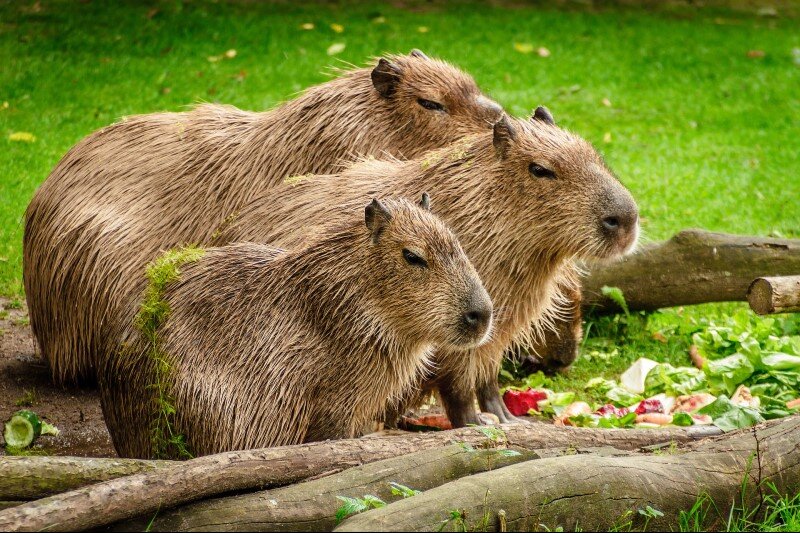Being the largest country in South America and the fifth-largest country in the world comes with a lot of expectations, and Brazil exceeds them all. Due to the massive size of the country, Brazil has around 4,655 miles of coastline, borders every country in South America except for two, and is where 60% of the Amazon rainforest is located. Because there is so much rain forest, it is no surprise that Brazil is home to around one-tenth of all species in the world which accounts for almost 55,000 plant species, 3000 kinds of freshwater fish, and over 690 mammals. Here are a few of the species of unique animals that you might get the opportunity to see on your next rainforest adventure in Brazil!
Capybara
The first on the list of animals that you might be able to see while exploring Brazil are capybaras. Capybaras are the largest rodent species alive today, can weigh up to 150 pounds, and eat upwards of six-and-a-half pounds of grass per day! These semi-aquatic mammals are known for living in groups that range from ten members to 100 members depending on the season. Capybaras are now a protected animal in Brazil, and are definitely worth taking the time to seek out in their favorite places including dense forests or near bodies of water!
Maned Wolf
Maned wolves are the next animal that you may be able to see when visiting Brazil. Don’t let their name fool you though, while maned wolves are canines and are related to wolves, they are more closely related to a fox. Their long, red-brown hair fur that covers their body resembles a fox and also gives the illusion that they have a mane and is the origin of its name. This omnivorous animal can grow to about three feet tall at the shoulder and can reach up to 51 pounds. Due to its intimidating size, it is often mistaken for more dangerous animals, but maned wolves are often shy/timid animals that avoid contact with anyone. They may be one of the hardest animals to locate and will take some patience if you want to see one in the wild!
Brazilian Tapir
The next animal on the list, the Brazilian tapir, looks like it belongs in another world. The Brazilian tapir is one of four species of tapirs which are close relatives of rhinoceros and what the tapir lacks in horn, it makes up for with its long, flexible snout that is used to grab the branches, fruits, and leaves that they eat. Brazilian tapirs can grow to weigh between 350-550 pounds and grow to an average length of 6 feet. They have four toes on each front foot and three toes on each back foot to help them walk on the soggy ground that they live on. If you are really lucky, you may even be able to see a baby tapir which is recognizable by the white stripes that they are born with but lose as they mature!
Greater Rhea
With long, powerful legs and a close relation to ostriches and emus, the greater rhea is the largest bird in all of South America and is one of the most interesting animals that you might be able to see when visiting Brazil. This 3-5 foot, the 50-pound bird is flightless, like it’s relatives, and can often be seen using its wings for balance or to help change direction when running from danger. Greater rheas are solitary animals throughout most of the year, but if you choose to visit during winter, you have a good chance of seeing a large mixed herd of greater rheas, deer, and/or guanacos!
Giant Anteater
Next up, with no teeth and a two-foot tongue, is the giant anteater. The giant anteater is the largest anteater species in the world, reaching up to eight feet in length, and is able to eat hundreds of ants and termites a minute with its special tongue. Aside from its incredible eating capabilities, the giant anteater is also a force to be reckoned with if they feel threatened. In an instance of danger, the giant anteater will rear up, balancing with its tail, and use its four-inch-long claws to fight off whatever predator is threatening. Make sure to not get too close if you are able to see one of these wonderful creatures when you are in Brazil.
Jaguarundi
Last but definitely not least on the list of animals that you might get the opportunity to see while visiting Brazil is the Jaguarundi. While they are closely related to cougars, this small feline only grows to about twice the size of an average house cat and can weigh anywhere from 6 to 20 pounds. Jaguarundi have little ears, short legs, long bodies, and even longer tails and while they are small in size, they should not be underestimated. Keep an eye out for this elusive feline when you next venture through the Amazon rainforests.
Brazil is said to have the greatest biodiversity in the world and these animals make up a very, very small percentage of that. There are so many beautiful and wonderful animals to see when you visit. Let Acanela help you plan your next Amazon rainforest adventure to Brazil in order to see these animals and so many more!
Post written by Jaide Matson






